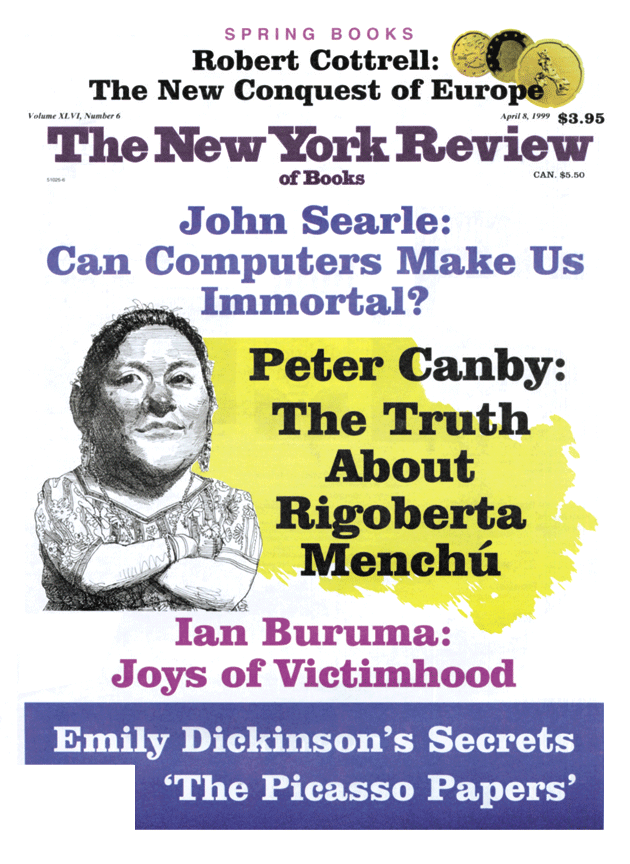In response to:
A Big Business from the June 11, 1998 issue
To the Editors:
David Brion Davis, in his wide-ranging account of the “Big Business” of slavery [NYR, June 11, 1998], is led by one of the authors under review to address the claims-rather tired in the 1990s-that the industrial revolution rested upon slavery and the slave trade. We are offered the perspectives that slavery’s horrific “discipline” contributed to the industrial revolution not only by providing profits for investment but by establishing “the evolution of industrial discipline and principles of capitalist rationalization.”
This seems a stretch. Professor Davis would have done well to include a more plausible and very old account of the economic impact of slavery in nineteenth-century America: that its impact was negative, corrupting of the spirit of enterprise, and demonstrably destructive of the masters as well as of the slaves. Making the best of the meager research materials available to him in addition to his own observations, Alexis de Tocqueville achieved before 1830 a remarkably compelling demonstration that slavery made everybody worse off.
In the Democracy in America chapter on “The Present and Probable Future Condition of the Three Races that Inhabit the Territory of the United States,” de Tocqueville made the valley of the Ohio into a sort of controlled experiment on the economic impact of slavery. “Upon the left bank of the Ohio labor is confounded with the idea of slavery, while on the right bank it is identified with that of prosperity and improvement….” “Upon the left bank of the stream the population is sparse; from time to time one descries a troop of slaves loitering in half-desert fields; the primeval forest reappears at every turn; society seems to be asleep….” “From the right bank, on the contrary, a confused hum is heard, which proclaims afar the presence of industry; the fields are covered with abundant harvest; the elegance of the dwellings announces the taste and activity of the laborers, and man appears to be in the enjoyment of that wealth and enjoyment which is the reward of labor.”
Remarkably, our most prescient foreign booster was able also to bring to bear useful population and economic data to demonstrate that Ohio was more attractive to immigrants and more economically successful than Kentucky, notwithstanding a bit of a head start for the latter. And he adds that “the activity of Ohio is not confined to individuals, but the undertakings of the state are surprisingly great: a canal has been established between Lake Erie and the Ohio….”
Professor Davis’s otherwise scholarly contribution needed this perspective.
Steven Flanders
Pelham, New York
David Brion Davis replies:
In Slavery and Human Progress (Oxford University Press, 1984), I not only discuss Tocqueville’s comparison of the northern and southern banks of the Ohio River but show that he had been thoroughly prepared to make such observations by Joel Poinsett, Josiah Quincy, John Quincy Adams, and especially Joseph Story. I also point out that Lord Durham, who traveled along the Canadian-American border in 1838, used almost identical imagery to contrast the “activity and bustle” of the American side with the “waste and desolate” of the “unenterprising” Canadians. Clearly slavery could not account for Canada’s seeming backwardness, nor can northern Kentucky give us insight into the extraordinary economic growth of the antebellum South.
Before generalizing about the economics of American slavery, I respectfully suggest that Mr. Flanders consult more recent sources than Tocqueville (whose work on America was published in 1835 and 1840, not “before 1830”), such as Without Consent or Contract: The Rise and Fall of American Slavery (Norton, 1989), by Robert William Fogel, who in 1993 won the Nobel Prize in Economic Science. While there is still some controversy over relatively minor issues, there can be no doubt that Fogel, Stanley L. Engerman, and their many students have demolished the myths about slavery that Steven Flanders describes.
This Issue
April 8, 1999


